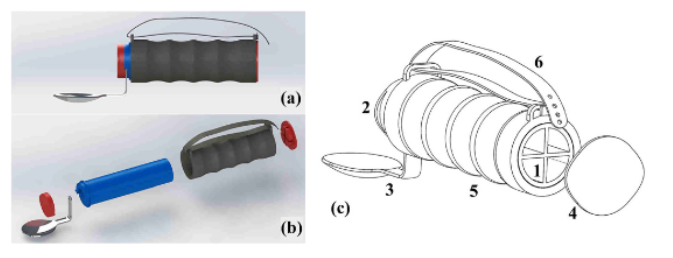In the recently published, ‘User-centered design of a customized assistive device to support feeding,’ Brazilian researchers explore the design of a medical device for patients with Parkinson’s or other diseases that cause hand tremors. Gaining nutrition is critical to health, and with such a device, the user also retains independence.
The authors suggested the user-based approach, with 3D printing used to improve and refine the design in the end. Overall, they were able to open up communication between members of the design team, offer clear identification of design demands, promote a decrease in R&D time, and offer an array of new and ‘inventive’ solutions. Here, the user helping the researchers in the study was a 60-year-old male with Parkinson’s.
While assistive technology has been heavily affected by 3D printing, in this study it also proves itself as a substantial design tool. The design process for the study was made up of these three stages:
- Informational and conceptual design
- Manufacturing
- Testing and refinement
The conceptual model consisted of:
- Main cable in which other pieces are fixed
- Cap for holding cutlery
- Back sealing cap
- Ergonomic cover
- Adjustable strap
“The cable also contains four internal cavities, which may or may not be filled with water, totaling five possible configurations of weight for the device, the heavier being twice its weight totally empty,” stated the researchers.
Main features of the design were:
- Mechanical system
- Non-toxic fluid for balance of tremors
- Easy assembly/disassembly
- Improved hand contact area
The device ultimately met all of the users’ design requirements, along with offering the potential for customization that is very affordable.
“The use of 3D printing for the generation of mock-ups and prototypes allowed a better visualization of the proposed technical solutions, facilitating the process of refining the product concept. It also allowed for greater and more effective participation of the stakeholders (occupational therapists, end users) in the design process through the interaction and testing with the prototypes, significantly collaborating for a user-centered design approach,” concluded the researchers.
“Single-case testing with users will be critical in evaluating product functionality and possible future improvements. Although the results with the use of the AD with no filled cavity (intervention phase B) have not yet been conclusive, it is expected that this may change with the beginning of cavity filling (intervention phase C).”
A variety of different medical devices have been created with 3D printing and especially in the last few years, from biomedical devices to those using 3D printed magnets to further the concept, to innovating with carbon. For this study, one of the most unique atmosphere was having the patient help with the project overall for creating parts and prototypes for assistive devices.
What do you think of this news? Let us know your thoughts! Join the discussion of this and other 3D printing topics at 3DPrintBoard.com.
[Source / Images: ‘User-centered design of a customized assistive device to support feeding’]
Subscribe to Our Email Newsletter
Stay up-to-date on all the latest news from the 3D printing industry and receive information and offers from third party vendors.
You May Also Like
Gorilla Sports GE’s First 3D Printed Titanium Cast
How do you help a gorilla with a broken arm? Sounds like the start of a bad joke a zookeeper might tell, but it’s an actual dilemma recently faced by...
Nylon 3D Printed Parts Made More Functional with Coatings & Colors
Parts 3D printed from polyamide (PA, Nylon) 12 using powder bed fusion (PBF) are a mainstay in the additive manufacturing (AM) industry. While post-finishing processes have improved the porosity of...
$25M to Back Sintavia’s Largest Expansion of Metal 3D Printing Capacity Since 2019
Sintavia, the digital manufacturing company specializing in mission-critical parts for strategic sectors, announced a $25 million investment to increase its production capacity, the largest expansion to its operations since 2019....
Velo3D Initiates Public Offering in a Bid to Strengthen Financial Foundations and Drive Future Growth
Velo3D (NYSE: VLD) has been among a number of publicly traded 3D printing firms that have attempted to weather the current macroeconomic climate. After posting a challenging financial report for 2023,...


































